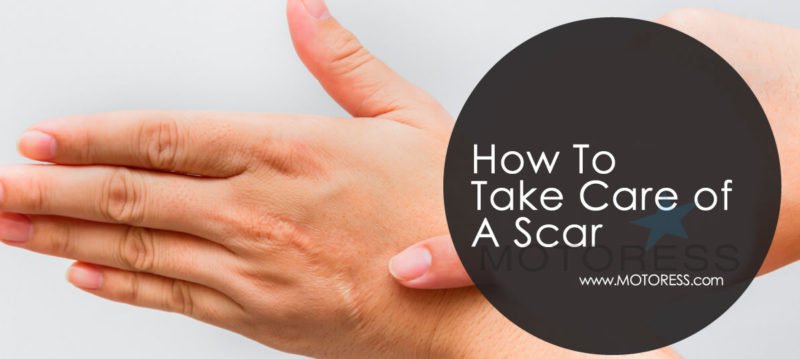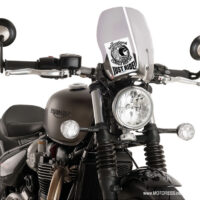Last Update: 2 January 2024

Working around motorcycles is rough. What with all the hard metal and chrome parts we often experience bumps, bruises and eventually scars. Even while riding we can unknowingly hit, scrape or bruise ourselves. And generally, any fall, crash or mishap usually results in a scar even under protective clothing. And if you’re a motorsporter, racer or off-road enthusiast, you’ve certainly a few “tell-tale” souvenirs to show. Here’s all you need to know on how to take care of a scar!
Generally scars cannot be totally removed but their appearance can be noticeably reduced. Though not be life threatening scars can cause distress and disruption as a result of anxiety. Scars can even cause depression and low self-esteem, as well as physical complaints like itching, tenderness, pain and sleeping problems.
Before deciding on any course of treatment, question what is bothering you: appearance or discomfort, as this may have an effect on the treatment you choose.
The good news is that a recent scar will fade to a paler mark after two to three years, and if it’s still upsetting you after that there are lots of treatments available to help make them even less noticeable.
TYPES OF SCARS
- Fine line: a fine white line that fades with time, often caused by surgery or knife wounds.
- Widespread: also known as ‘stretched scars’, these are a result of the gradual stretching of fine lines, which takes place a few weeks after surgery. Stretch marks that appear after pregnancy are another variation of the stretched scar.
- Scar contractures: commonly identified as burns that lie across joints.
- Atrophic: usually an after-effect of acne or chicken pox. Small and round in appearance with an inverted centre.
- Raised skin scars: known as either hypertrophic (often red, itchy and inflamed, but don’t grow beyond their original size), or keloid (large and bulky scars that gradually grow bigger).
WHEN TO GET A SCAR TREATED
It’s uncommon for scars to be treated for at least a year as their overall appearance often changes dramatically in the early stages. During this time you should monitor their appearance and also be aware of any other physical and psychological symptoms they may be causing. Before deciding on any course of treatment, question what is bothering you: appearance or discomfort, as this may have an effect on the treatment you choose. Your choices will also be limited by the type of scar you have and the money you can spend. Always visit your GP before you make any decisions about what treatments you want.
TEMPORARY SCAR TREATMENTS
- Camouflage creams: These are highly pigmented cover-up creams that are usually waterproof and come in a number of different skin tones.
- Steroid injections: The form of steroid used here helps reduce inflammation. It’s given as a course of jabs, directly injected into keloid scars.
- Temporary filler injections: Used to help ‘fatten up’ the skin beneath sunken scars, in particular the pitted type left by acne. Until recently, collagen was the main choice of filler, but there are now many different kinds on the market. Injections need to be repeated on a regular basis, however, if you want the effect to remain.
PERMANENT SCAR TREATMENTS
Laser surgery: A technique that involves using a beam of high-energy light to cut away the upper surface of the skin. The procedure is very precise, although the laser focus can be adjusted to resurface larger areas. It also stimulates both blood supply and collagen production – the support network for skin tissue. Just be aware that it can take about 10 months for collagen to regenerate, so don’t expect to see the finished results until then. Consult your GP for more information.
Dermabrasion: ‘Surgical sandpapering’, using specialist equipment and often performed under a general anaesthetic. The aim is to remove the scarred surface of the skin, so it can be painful and result in temporary scabbing.
Surgical scar revision: A surgical procedure that removes scars and rejoins the skin as naturally as possible. Can make noticeable improvement to wide scars that can be cut out and closed into a thinner line, and long scars that can be made shorter.
Punch grafts and excisions: Punch grafts use unscarred skin (often from behind the ear) to fill in a hole left by a tiny instrument that removes the original scar. Excisions involve closing the same holes with stitches. Best for deep or ‘pitted’ acne scars.
Emollient creams: Long-term use of Vitamin A-based emollient creams such as Retinova has been proven to reduce some scars left by acne.
Silicone gel sheets: Waterproof and flexible sheets of silicone gel that can be cut and shaped to fit the affected area and help to soften scars and reduce any redness. Available over the counter from your chemist.
NOTE: Before exploring treatments, always consult your family doctor, physician or specialist.




